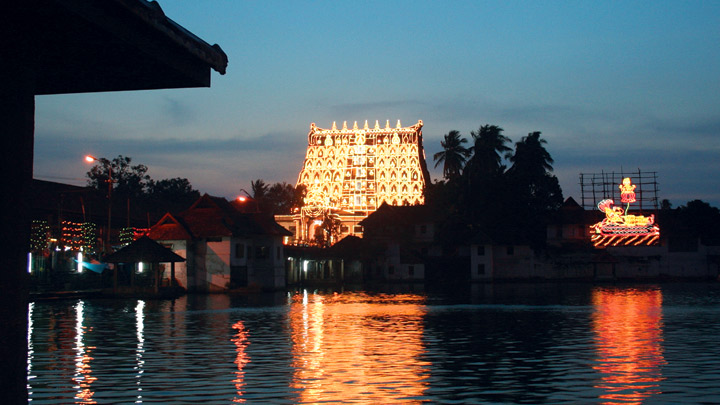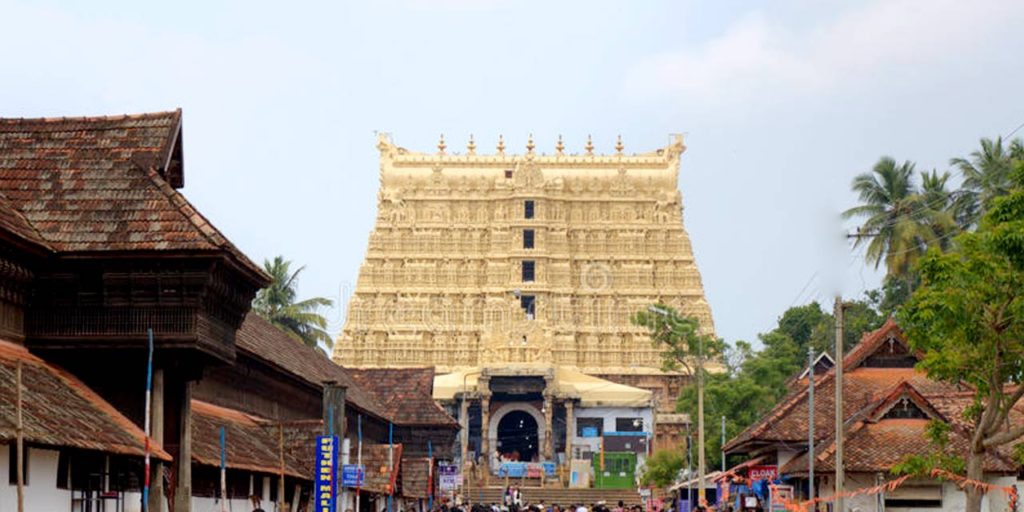
The origin of the Temple of Sree Padmanabhaswamy is lost in antiquity. It is not possible to determine with any exactitude, from any reliable historical documents or other sources as to when and by whom the original idol of Sree Padmanabhaswamy was consecrated. The Temple has references in Epics and Puranas. Srimad Bhagavatha says that Balarama visited this Temple, bathed in Padmatheertham and made several offerings. Nammalwar, 9th century poet and one among the 12 Vaishnavite saints of the Alvar tradition, has composed ten hymns in praise of Lord Padmanabha. Some well known scholars, writers and historians, like the late Dr. L.A.Ravi Varma of Travancore, have expressed the view that this Temple was established on the first day of Kali Yuga (which is over 5000 years ago). The legends of the Temple are handed down through the centuries. One such legend which finds a place in the old palm leaf records of the Temple, as also in the famous grantha entitled “Ananthasayana Mahatmya”, mentions that it was consecrated by a Tulu Brahmin hermit named Divakara Muni. On the 950th year of Kali Yuga a reinstallation of the idol was done. In the 960th Kali year King Kotha Marthandan built the Abhisravana Mandapam.
Sree Padmanabhaswamy
The marvelous idol of Sree Padmanabhaswamy is seen reclined on the mighty five hooded serpent Anantha. The supreme God is in conscious cosmic slumber with the head positioned to the south and the feet to the north. Anantha (or the endless) spreads its hoods above the head of the Idol. The three coils represent the three characteristics of mankind Sattva, Rajas and Tamas and its five hoods indicate the Panchendriyas(five senses) or the five elements(Panchabhootas). From the navel of the Lord emerges a lotus on which Lord Brahma, the Creator, is seated. Just below the stretched right arm of the Lord is the Shiva Linga of the Destroyer. Brahma, Vishnu(Padmanabha) and Shiva represent the ‘Srushti, Stithi and Samharam’.
The residing potency was drawn from the original Idol which was made of Iluppa wood and infused into the present Idol by certain complicated religious ritualistic processes. The Idol is made up of a highly complex amalgam termed Katusarkarayogam and contains within it 12008 Salagramas collected from the bed of the River Gandaki in Nepal. It is believed that Salagramas represent Lord Vishnu. Twelve Salagramas when worshipped together gain the potency of a Mahakshetram(Great Temple). Thus the mighty Ananthasayana Moorthy here gains the greatness and sanctity of a thousand Mahakshetrams.
The sanctum sanctorum has three entrances representing the three stages of times. It is only through those doors that we can observe the Deity.
Vishwaksenan
This idol in sitting posture, facing the South, is given great prominence as Vishwaksenan is Mahavishnu’s Nirmalya moorthy.
Sree Ramaswamy with His consort Seetha and brother Lekshmanan
We can see two sets of idols of Sree Ramaswamy with Seetha and Lekshmanan. Of these, one set of idols are in the regal style while the other represent the Lord’s tenure at Dandakaranyam(Forest). The image of Sree Hanuman is there as an orderly to Lord Rama. Idols of an eight armed Ganapathy with a Devi seated on His lap and a small Kaliyamardana Krishna are also present.
Sree Yoga Narasimha Moorthi
The shrine for Sree Narasimha Swamy is located to the South of the main sanctum. Sree Narasimha Moorthy is the fourth incarnation of Lord Maha Vishnu and assumes the form of Man and Lion. The image is in the ‘Ugra roopam’, hence powerful. To pacify Him, Ramayana is being recited throughout the time when the Temple doors are open. This idol, made of Panchaloham, faces the East. This is the second major deity of this Temple.
Sree Veda Vyasar and Ashwathama
The shrine of Sage Veda Vyasar (who gave life to the great Epic Mahabharatha and other religious texts) with Ashwathama is located on the north of the cheruchuttu. This shrine faces the West. Veda Vyasa shrines are rare in India. Both idols are made of Panchaloham.
Thiruvambadi Sreekrishnaswamy
The Thiruvambadi Temple enjoys the status of an independent temple within this Temple complex. This shrine has a Namaskara Mandapam with fine display of carvings in wood, a Balikkal and a silver flag pole. The image of Sree Krishna as Parthasarathy is of medium built and is in stone. He is the third major Deity of Sree Padmanabha Swamy Temple.
Kshethrapaalakan
The idol of Kshethrapaalakan in the sitting posture faces the East. His shrine is located on the Northern side of the Temple. Kshethrapaalakan is considered as one of the eight Bhairavas of Shiva who perform the role of protector to temples. There is also an idol of Lord Ganesha, in this shrine.
Agrashaala Ganapathi
This idol is installed in the cooking area of the Temple. The belief is that Lord Ganesh witnesses and oversees the Annadanam(offering of free food) organized by the Temple.
Hanuman Swamy, Ashtanaga Garuda Swamy and the Maha Meru Chakram
Near the golden flag pole we see the towering image of Sree Hanuman Swamy in full relief. To His left is Sree Ashtanaga Garuda Swamy. On the ceiling between these images is the Maha Meru Chakram complete with the Bindu or the central point which is engraved in clear focus. This cosmic wheel enhances the spiritual strength of Sree Hanuman.
Sree Dharma Sastha
The Swayambhu Dharma Sastha in Yogasanam or Yogic posture on the South side of the Temple is an independent shrine. This idol is made of granite and faces the East.

Darshan Timing
Morning
03.15 am to 04.15 am (Nirmalya Darshanam)
06.30 am to 07.00 am
08.30 am to 09.15 am
Evening
05.00 pm to 06.15 pm
06.45 pm to 07.20 pm
The above-indicated time schedule is subject to changes during festivals and other special occasions. During the festival occasions the darshan time is reduced in order to performing the special poojas